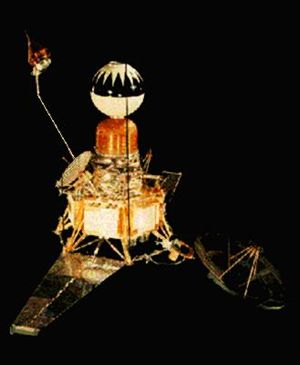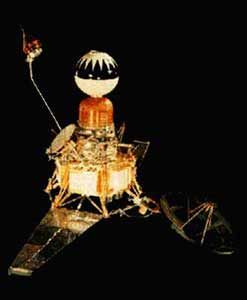
Home - Search - Browse - Alphabetic Index: 0- 1- 2- 3- 4- 5- 6- 7- 8- 9
A- B- C- D- E- F- G- H- I- J- K- L- M- N- O- P- Q- R- S- T- U- V- W- X- Y- Z
Ranger 3-4-5
 Ranger 3, 4, 5 Credit: NASA |
Status: Operational 1962. First Launch: 1962-01-26. Last Launch: 1962-10-18. Number: 3 . Gross mass: 331 kg (729 lb).
The ambitious middle series of Ranger spacecraft were designed to transmit pictures of the lunar surface to Earth stations (during a period of 10 minutes of flight prior to impacting on the Moon), to rough-land a seismometer capsule on the Moon, to collect gamma-ray data in flight, to study radar reflectivity of the lunar surface, and to continue testing of the Ranger program for development of lunar and interplanetary spacecraft.
The basic vehicle consisted of a lunar capsule covered with a balsa wood impact-limiter, 27.5 cm in diameter, a retrorocket with a silvered plastic thermal shield, and a gold- and chrome-plated hexagonal base 1.5 m in diameter. Two wing-like solar panels (5.2 m across) were attached to the base and deployed early in the flight. Power was generated by solar panels containing 8680 solar cells. The capacity of the AgZn launching and backup battery was 1000 W-hours, and the six AgCd batteries were capable of operating the lunar capsule transmitter for 30 days.
The experimental apparatus included: (1) a vidicon television camera, which employed a scan mechanism that yielded one complete frame in 10 s; (2) a gamma-ray spectrometer; (3) a radar altimeter; (4) a seismometer to be rough-landed on the lunar surface; (5) an earth-controlled command system; (6) telemetry; (7) a power supply of AgZn batteries charged by solar cells; and (8) timing, orientation, and temperature control devices. Telemetry aboard the spacecraft included two 960 MHz transmitters, one at 3 W power output and the other at 50 mW power output.
The combined lunar impact/landing mission on these early probes proved too ambitious and none successfully completed their missions.
Family: Moon. Country: USA. Launch Vehicles: Atlas, Atlas Agena B. Projects: Ranger. Launch Sites: Cape Canaveral, Cape Canaveral LC12. Agency: JPL, NASA. Bibliography: 16, 2, 278, 296, 4040, 4045, 4055, 6.
 | Ranger 3, 4, 5 Credit: NASA |
 | Ranger 3 Credit: Manufacturer Image |
1959 December 21 - .
- Unmanned program of five lunar spacecraft flights described - .
Nation: USA.
Related Persons: Pickering.
Program: Ranger.
Spacecraft Bus: Ranger.
Spacecraft: Ranger 3-4-5.
A guideline letter was sent to William H. Pickering, Director of the Jet Propulsion Laboratory (JPL), from Abe Silverstein, Director of NASA's Office of Space Flight Development, outlining a program of five lunar spacecraft flights, intended primarily to obtain information on the lunar surface. JPL was requested to conduct tradeoff studies on spacecraft design and mission. The scientific objective would be to "acquire and transmit a number of images of the lunar surface." In addition, JPL was asked to "evaluate the probability of useful data return from a survivable package incorporating . . . a lunar seismometer of the type . . . being developed for NASA." This letter provided the formal basis for what was subsequently the Ranger program.
1960 May 4 - .
- Ranger project named - .
Nation: USA.
Program: Ranger.
Spacecraft Bus: Ranger.
Spacecraft: Ranger 3-4-5.
Clifford I. Cummings, Jet Propulsion Laboratory spacecraft program director, announced at a meeting of the Aviation Writers Association in Los Angeles, Calif., that the spacecraft which would carry television and a detachable instrumented capsule to be crash-landed on the moon would be called "Ranger."
1961 July 24 - .
- Contract for television system for Ranger - . Nation: USA. Program: Ranger. Spacecraft Bus: Ranger. Spacecraft: Ranger 3-4-5. NASA issued a letter contract to the Astro-Electronic Division of Radio Corporation of America to develop and fabricate the high-resolution television system (including associated communication and electronic equipment) for the Ranger program..
1962 January 26 - . 20:30 GMT - . Launch Site: Cape Canaveral. Launch Complex: Cape Canaveral LC12. LV Family: Atlas. Launch Vehicle: Atlas Agena B. FAILURE: Agena B second stage guidance system failure. Failed Stage: U.
- Ranger 3 - .
Payload: NASA P-34 (RA-3). Mass: 327 kg (720 lb). Nation: USA.
Agency: NASA.
Program: Ranger.
Class: Moon.
Type: Lunar probe. Spacecraft Bus: Ranger.
Spacecraft: Ranger 3-4-5.
USAF Sat Cat: 221 . COSPAR: 1962-Alpha-1.
Lunar impact probe; missed the moon by 36,874 km and went into solar orbit. A malfunction in the booster guidance system resulted in excessive spacecraft speed. Reversed command signals caused the telemetry antenna to lose earth acquisition, and mid-course correction was not possible. Some useful data were obtained from the flight. Of four scientific experiments only one was partially completed: gamma-ray readings of the lunar surface. Attempts to relay television pictures of the moon and to bounce radar signals off the moon at close range were unsuccessful.
1962 April 23 - . 20:50 GMT - . Launch Site: Cape Canaveral. Launch Complex: Cape Canaveral LC12. LV Family: Atlas. Launch Vehicle: Atlas Agena B.
- Ranger 4 - .
Mass: 328 kg (723 lb). Nation: USA.
Agency: NASA.
Program: Ranger.
Class: Moon.
Type: Lunar probe. Spacecraft Bus: Ranger.
Spacecraft: Ranger 3-4-5.
Decay Date: 1962-04-26 . USAF Sat Cat: 280 . COSPAR: 1962-Mu-1.
The 6555th Aerospace Test Wing launched an Atlas D/Agena B vehicle that carried NASA's Ranger IV to the moon. This was the first U.S. instrument package to impact on the moon. Ranger IV was launched by an Atlas-Agena B booster from the Atlantic Missile Range, attained a parking orbit, and was fired into the proper lunar trajectory by the restart of the Agena B engine. Failure of a timer in the spacecraft payload caused loss of both internal and ground control over the vehicle. The Goldstone Tracking Station maintained contact with the spacecraft until it passed behind the left edge of the moon on April 26. It impacted at a speed of 9,617 km per hour, the first American spacecraft to land on the lunar surface. The Agena B second stage passed to the right of the moon and later went into orbit around the sun. Lunar photography objectives were not achieved.
1962 October 15 - .
- Ranger 3 showed that gamma-rays greater than expected - .
Nation: USA.
Program: Ranger.
Spacecraft Bus: Ranger.
Spacecraft: Ranger 3-4-5.
The analysis of scientific measurements made by the Ranger III lunar probe showed that gamma-ray intensity in interplanetary space was ten times greater than expected, NASA reported. Measurements were taken by gamma-ray spectrometers on Ranger III after it was launched on January 26. NASA scientists, however, did not believe that gamma-ray intensity was "great enough to require any changes in the design of radiation shielding for manned spacecraft."
1962 October 18 - . 16:59 GMT - . Launch Site: Cape Canaveral. Launch Complex: Cape Canaveral LC12. LV Family: Atlas. Launch Vehicle: Atlas Agena B.
- Ranger 5 - .
Mass: 340 kg (740 lb). Nation: USA.
Agency: NASA.
Program: Ranger.
Class: Moon.
Type: Lunar probe. Spacecraft Bus: Ranger.
Spacecraft: Ranger 3-4-5.
USAF Sat Cat: 439 . COSPAR: 1962-B-Eta-1.
The Ranger V lunar probe was launched from Atlantic Missile Range by an Atlas-Agena B launch vehicle. The Agena B stage attained parking orbit and 25 minutes later reignited to send Ranger V toward the moon. A malfunction in the Agena B guidance system resulted in excessive spacecraft velocity. The spacecraft's solar cells did not provide power and reversed command signals caused the telemetry antenna to lose earth acquisition. This made reception of the flight-path correction signal impossible and rendering its television cameras useless. Reversed command signals caused the telemetry antenna to lose earth acquisition, and mid-course correction was not possible. The spacecraft missed the Moon by 725 km and went into solar orbit. Gamma-ray data were collected for 4 hours prior to the loss of power. Ranger V was to have relayed television pictures of the lunar surface and rough-landed an instrumented capsule containing a seismometer. The spacecraft was tracked for 8 hours, 44 minutes, before its small reserve battery went dead. Additional Details: here....
Back to top of page
Home - Search - Browse - Alphabetic Index: 0- 1- 2- 3- 4- 5- 6- 7- 8- 9
A- B- C- D- E- F- G- H- I- J- K- L- M- N- O- P- Q- R- S- T- U- V- W- X- Y- Z
© 1997-2019 Mark Wade - Contact
© / Conditions for Use